
Last Updated on Nov 1, 2020
Seating Arrangement forms a major chunk of questions from Reasoning Ability section. Today, we are going to provide you with some important tips for the seating arrangement questions.
These questions may be asked in the following forms –
- Linear Arrangement
- Circular Arrangement (inward, outward or both side facing)
- Square/Rectangular Arrangement (inward, outward or both side facing)
- Combination of the above three with puzzles.
Type 1: Linear Arrangement
This type of question may be asked in a single row or double row arrangement. You need to take special care of the directions of the people here. Suppose 5 people are sitting in a single row.

How to Solve Linear Arrangement
Eight friends Q, R, S, T, V, W, Y & Z are sitting around a circular table facing the center, not necessarily in the same order. There are 3 males and 5 females in the group. No two males are immediate neighbors of each other.
- V sits second to the right of his wife.
- S sits third to the right of V.
- W sits second to the right of her husband Z.
- Z is not an immediate neighbor of V’s wife.
- T is a male and Y is not an immediate neighbor of V.
- R sits second to the right of Q.
Now, the first 2 conditions give one possible arrangement –

As per 3rd and 4th condition, the following arrangements are possible –

Although we will get 3 probable positions of Z, 1st and 3rd arrangements are not possible since we can’t place W in these cases, also, V and Z can’t be placed together since both are male and this violates the constraint of the question. So, we proceed with the 2nd arrangement.
Now, as per 5th condition, T being a male can’t be placed adjacent to V and hence only one place is left for T to be placed. Also, Y is not an immediate neighbor of V, so Y will be placed at V’s wife’s place. Q and R can be placed as per the 6th condition.

Type 2: Circular Arrangement
The circular arrangement is a type of seating arrangement where people are seated around a circular or square or polygonal table. There are, primarily, three types of questions under the circular arrangement.
1) A circular arrangement with people facing the center of a table.
2) A circular arrangement with people facing outward of a table.
2) A circular arrangement with some people facing the center of a table whereas some people facing outward
In the below arrangement, some persons are sitting around a circle and they are facing the center. The diagram highlights the left and right of the people in this case.

Movements around the circular arrangement
For the people facing the center:
1. Left movement is called clockwise rotation.
2. Right movement is called anti-clockwise rotation.
When people will be facing outside, the opposite will be true:
1. Left movement is called anti-clockwise rotation.
2. Right movement is called clockwise rotation.
The information given in such questions specifies the position of a few or all the persons in the arrangement. The positions are specified through conditions like a particular person is sitting right or left of the other person. After reading the given information, you should draw the diagram depicting the question statement.
Example: A, B, C, D, E, F, G & H are sitting around a circular area at equal distances between each other, but not necessarily in the same order. Some of the people are facing the center while some face outside (i.e. in a direction away from the center).
Facing the same direction means if one faces the center then other also faces the center and vice versa. Facing the opposite direction means if one person faces the center then the other faces outside and vice versa.
B faces outside. D sits second to the left of B. A and F are immediate neighbours of D. H sits second to the right of A. C sits third to the left of H. E sits to the immediate right of G. D sits third to the left of E. D faces the same direction as H. F sits to the immediate right of C. F and G take same directions. Find the desired arrangement.
Solution
Let us try to solve this question clue by clue:
B faces outside:
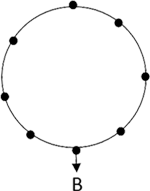
After fixing B’s position, we can see that D will be in the anti-clockwise direction from B and since D is second to the left, this means there will be 1 person in between them. But we don’t know the direction of D yet, so D can be facing inside or outside.
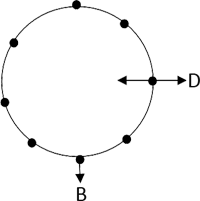
A and F are immediate neighbors of D. H sits second to the right of A. This would give rise to 4 possibilities. First, F can be between B & D and A will be on the other side of D. Secondly, A can be between B and D while F will be on the other side of D. Each case is explained below with possible directions of ‘A’ (inside/ outside).
A is sitting on the other side of D (not between B and D) and F is between B and D. Now A can face inside or outside. Now in case, we take A as facing outside, then 2nd to the right would be H whereas we know that this position belongs to F since it is A and F who are neighbors of D, so in this situation, we can take A to be facing only inside. We can also add H as 2nd anti-clockwise to A and place F between B and D. Directions, of F, D & H, are not clear yet, so they could be facing inside or outside.
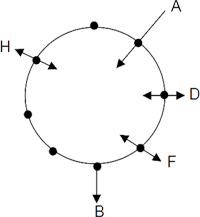
A could be between B and D while F could be on the other side of D. Again A could be facing outside or inside. Now in case, we take A, facing inside, then 2nd to his right would be H whereas we know that this position belongs to F since it is A and F who are neighbors of D. So in this position we can take A to be facing only outside. We can also add H at 2nd clockwise to A and F at the other side of D. Directions, of F, D and H, are not clear yet, so they could be facing inside or outside.
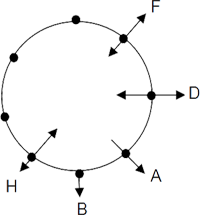
C sits third to the left of H & this clue will help us choose between the above 2 possibilities. Check the 1st diagram in point 2, whatever direction we take H to be at, the 3rd position, on his both sides, is already taken. So that one is rejected. We can continue the question further with the 2nd diagram in point 4. Also, we cannot take H to be facing outside, in that case moving 3 places anti-clockwise the position will clash/overlap with D. Hence H has to face inside.
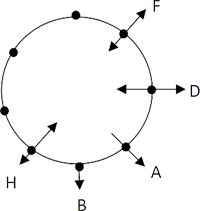
E sits to the immediate right of G. D sits third to the left of E. D faces the same direction as that of H. F sits to the immediate right of C. F and G take same directions:
D is 3rd to the left of E, so one cannot take E as facing outside since in that case, the 3rd left would mean the position occupied by B. Also D will face inside since his/her and H’s direction is same. Now since F has to be on the immediate right of C, it means C will be between E and F and will face outside. Now E has to be at the immediate right of G, this means that G will be between E and H will face outside. F will also face outside since it is given that F and G take same directions.
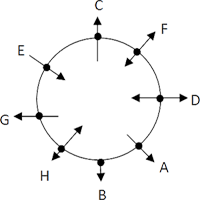
Summary
In this post, we have clearly explained Seating Arrangements in Linear and Circular Arrangement cases. These both arrangements are illustrated with detailed examples in simplified steps. There are some diagrams which are easy to understand and clear the concept. Also, share your views in the comment section below.
For related posts click here.
